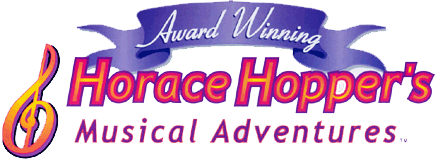
Program Creator Comments
In working with developmentally delayed children, the idea was to use music as a conduit to carry information into the mind of the child and provide a way for the child to respond verbally. MRI studies showed a leftward asymmetry of the brain, especially pronounced in children with advanced pitch recognition. This led us to believe that we could stimulate the Wernikes area, the seat of language comprehension, by developing the planum temporale, associated with pitch recognition. This premise is based on the close proximity of these two areas in the left frontal lobe and earlier research.
When we first started developing Horace Hopper, the idea was to create a music program for preschoolers that would be an enhanced learning tool. A tool that could be used in a home or institution to build skills in music: pitch recognition, tonal memory, eye/hand coordination, counting, melody construction, and familiarity with traditional instruments. At the same time we wanted to increase verbal and math skills.
We hoped to create an appreciation of music and the arts and enable the child to have a sense of self worth as a result of the experience of learning.
We designed it so that the music was an important part of an adventure. In our first program, the music is the backdrop for the dramatic events in which the child is an important part. In our new CD-ROM, the child paints with music, spells words with notes, matches musical tones while racing a flying duck, operates a musical kaleidoscope—all designed to capture the attention.
The studies of Gordon Shaw and Francis Raucher in the 90’s showed an increase in certain types of proportional math development and language proficiency associated with keyboard study in children. It was significant that singing alone did not accomplish this development: keyboard study was the causal factor. We designed Horace Hopper to use both keyboard and singing as parts of the whole process.
Language development was essential in the process. First, we first constructed a library of 430 essential words and had each word sung with emphasis on concise pronunciation. The child was then stimulated to sing the word with the voice in the computer as the image was displayed. We assembled 860 images with both pictures and illustrations of each word. Lists of words could be contructed for each child according to difficulty or interest. We instituted a 3 picture test similar to the Peabody Picture Assesment to measure improvement which could be recorded in each child’s file.
To understand how music and math are closely related, we must look at the science of acoustics. A single pitch is a series of vibrations that are perceived by the brain as both a tone color and a position of highness or lowness on the auditory scale. The overtones are a series of vibrations above the fundamental pitch that are a hierarchy of mathematical ratios.
The first ratio is 1:2 and forms the first overtone. This overtone can be heard as we strike the fundamental pitch and hear the octave above stimulated by the sound waves. The second ration is 2:3 and can be heard and octave and a fifth above the fundamental tone.
The relative strength of these mathematical ratios in a pitch determines the timbre of a sound: that is the difference between a clarinet sound and a flute sound. These ratios are subconsciously registered and used by the brain. The ability of the brain to develop skills related to this phenomenon is part of the strategy in Horace Hopper.
Rhythm is mathematical ratios in time. We have created a set of drums that use ratios of 1:2 to 1:16 in any combination. These can be manipulated by the child and played using a number of different instruments. We also have designed a program that allows the notes in a melody to be played in long or short durations by striking the space bar or Hopper Bopper, a click switch.
Each part of the CD-ROM is designed to be logically sequenced in learning. It requires no special skill to operate.
 |
 |
 |
 |
 |
 |
 |
 |
 |
 |
 |
| All images, logos, sounds, concepts, and content Copyright © 1999 Lonnie Liggitt. |